2018 PEUGEOT EXPERT deactivate airbag
[x] Cancel search: deactivate airbagPage 22 of 416
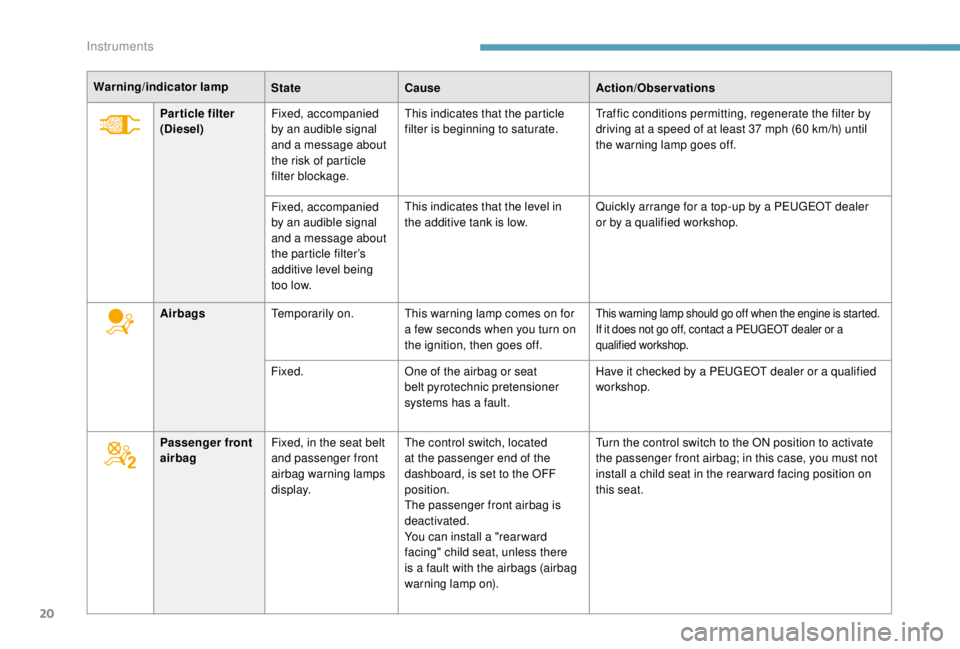
20
Warning/indicator lampStateCause Action/Observations
Airbags Temporarily on. This warning lamp comes on for
a few seconds when you turn on
the ignition, then goes off.
This warning lamp should go off when the engine is started.
If it does not go off, contact a PEUGEOT dealer or a
qualified workshop.
Fixed.One of the airbag or seat
belt pyrotechnic pretensioner
systems has a fault. Have it checked by a PEUGEOT dealer or a qualified
workshop.
Passenger front
airbag Fixed, in the seat belt
and passenger front
airbag warning lamps
display. The control switch, located
at the passenger end of the
dashboard, is set to the OFF
position.
The passenger front airbag is
deactivated.
You can install a "rearward
facing" child seat, unless there
is a fault with the airbags (airbag
warning lamp on). Turn the control switch to the ON position to activate
the passenger front airbag; in this case, you must not
install a child seat in the rear ward facing position on
this seat.
Par ticle filter
(Diesel)
Fixed, accompanied
by an audible signal
and a message about
the risk of particle
filter blockage. This indicates that the particle
filter is beginning to saturate.
Traffic conditions permitting, regenerate the filter by
driving at a speed of at least 37 mph (60 km/h) until
the warning lamp goes off.
Fixed, accompanied
by an audible signal
and a message about
the particle filter’s
additive level being
too low. This indicates that the level in
the additive tank is low.
Quickly arrange for a top-up by a PEUGEOT dealer
or by a qualified workshop.
Instruments
Page 23 of 416
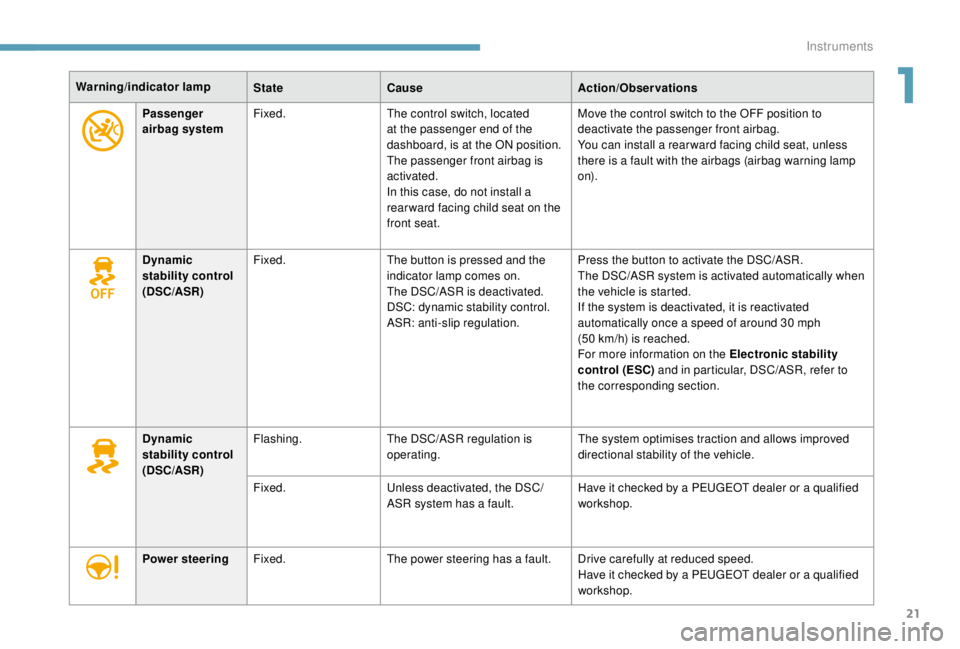
21
Passenger
airbag systemFixed.
The control switch, located
at the passenger end of the
dashboard, is at the ON position.
The passenger front airbag is
activated.
In this case, do not install a
rear ward facing child seat on the
front seat. Move the control switch to the OFF position to
deactivate the passenger front airbag.
You can install a rear ward facing child seat, unless
there is a fault with the airbags (airbag warning lamp
o n).
Warning/indicator lamp
StateCause Action/Observations
Dynamic
stability control
(DSC/ASR) Fixed.
The button is pressed and the
indicator lamp comes on.
The DSC/ASR is deactivated.
DSC: dynamic stability control.
ASR: anti-slip regulation. Press the button to activate the DSC/ASR.
The DSC/ASR system is activated automatically when
the vehicle is started.
If the system is deactivated, it is reactivated
automatically once a speed of around 30
mph
(50
km/h) is reached.
For more information on the Electronic stability
control (ESC) and in particular, DSC/ASR, refer to
the corresponding section.
Dynamic
stability control
(DSC/ASR) Flashing.
The DSC/ASR regulation is
operating. The system optimises traction and allows improved
directional stability of the vehicle.
Fixed. Unless deactivated, the DSC/
ASR system has a fault. Have it checked by a PEUGEOT dealer or a qualified
workshop.
Power steering Fixed. The power steering has a fault. Drive carefully at reduced speed.
Have it checked by a PEUGEOT dealer or a qualified
workshop.
1
Instruments
Page 146 of 416

144
Geolocation
Press this button for more than
2 seconds to request assistance
if the vehicle breaks down.
A voice message confirms that the call has
been made**. Pressing this button again
immediately cancels the request.
The cancellation is confirmed by a voice
message.
If an impact is detected by the airbag
control unit, and independently of the
deployment of any airbags, an emergency
call is made automatically.Operation of the system
When the ignition is switched on,
the green indicator lamp comes
on for 3
seconds indicating that
the system is operating correctly.
For all countries except Russia, Belarus
and Kazakhstan. The red indicator lamp flashes
then goes off: there is a system
fault.
The red indicator lamp is on continuously:
replace the back-up battery.
For Russia, Belarus and Kazakhstan. The red indicator lamp is on
continuously: there is a system
fault.
The red indicator lamp flashes: replace the
back-up battery.
In either case, the emergency and assistance
calls may not function.
Contact a qualified repairer as soon as
possible. The fault with the system does not prevent
the vehicle from being driven.
Peugeot Connect
Assistance
** As per the geographic coverage of
"Peugeot Connect SOS", "Peugeot Connect
Assistance" and the official national
language chosen by the owner of the
vehicle.
T
he list of countries covered and PEUGEOT
CONNECT services is available from
dealers or on the website for your country. You can deactivate geolocation by
simultaneously pressing the "Peugeot Connect
SOS" and "Peugeot Connect Assistance"
buttons, followed by a press on "Peugeot
Connect Assistance" to confirm.
To reactivate geolocation, simultaneously press
the "Peugeot Connect SOS" and "Peugeot
Connect Assistance" buttons again, followed
by a press on "Peugeot Connect Assistance"
to confirm.
If you purchased your vehicle outside the
Brand network, we invite you to have a
dealer check
the configuration of these services and,
if desired, modify it to suit
your wishes. In a multilingual country,
configuration is possible in the official
national language of your choice.
Safety
Page 156 of 416
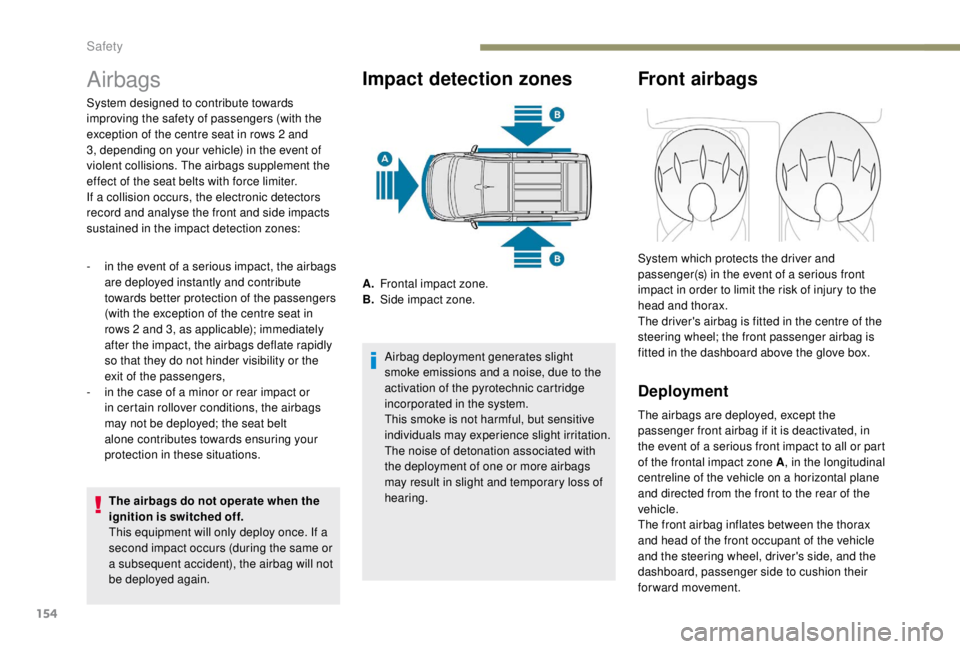
154
Airbags
The airbags do not operate when the
ignition is switched off.
This equipment will only deploy once. If a
second impact occurs (during the same or
a subsequent accident), the airbag will not
be deployed again.
Impact detection zones
Airbag deployment generates slight
smoke emissions and a noise, due to the
activation of the pyrotechnic cartridge
incorporated in the system.
This smoke is not harmful, but sensitive
individuals may experience slight irritation.
The noise of detonation associated with
the deployment of one or more airbags
may result in slight and temporary loss of
hearing.
A.
F
rontal impact zone.
B.
S
ide impact zone.
Front airbags
System which protects the driver and
passenger(s) in the event of a serious front
impact in order to limit the risk of injury to the
head and thorax.
The driver's airbag is fitted in the centre of the
steering wheel; the front passenger airbag is
fitted in the dashboard above the glove box.
Deployment
The airbags are deployed, except the
passenger front airbag if it is deactivated, in
the event of a serious front impact to all or part
of the frontal impact zone A
, in the longitudinal
centreline of the vehicle on a horizontal plane
and directed from the front to the rear of the
vehicle.
The front airbag inflates between the thorax
and head of the front occupant of the vehicle
and the steering wheel, driver's side, and the
dashboard, passenger side to cushion their
for ward movement.
System designed to contribute towards
improving the safety of passengers (with the
exception of the centre seat in rows 2
and
3, depending on your vehicle) in the event of
violent collisions. The airbags supplement the
effect of the seat belts with force limiter.
If a collision occurs, the electronic detectors
record and analyse the front and side impacts
sustained in the impact detection zones:
-
i
n the event of a serious impact, the airbags
are deployed instantly and contribute
towards better protection of the passengers
(with the exception of the centre seat in
rows 2
and 3, as applicable); immediately
after the impact, the airbags deflate rapidly
so that they do not hinder visibility or the
exit of the passengers,
-
i
n the case of a minor or rear impact or
in certain rollover conditions, the airbags
may not be deployed; the seat belt
alone contributes towards ensuring your
protection in these situations.
Safety
Page 160 of 416
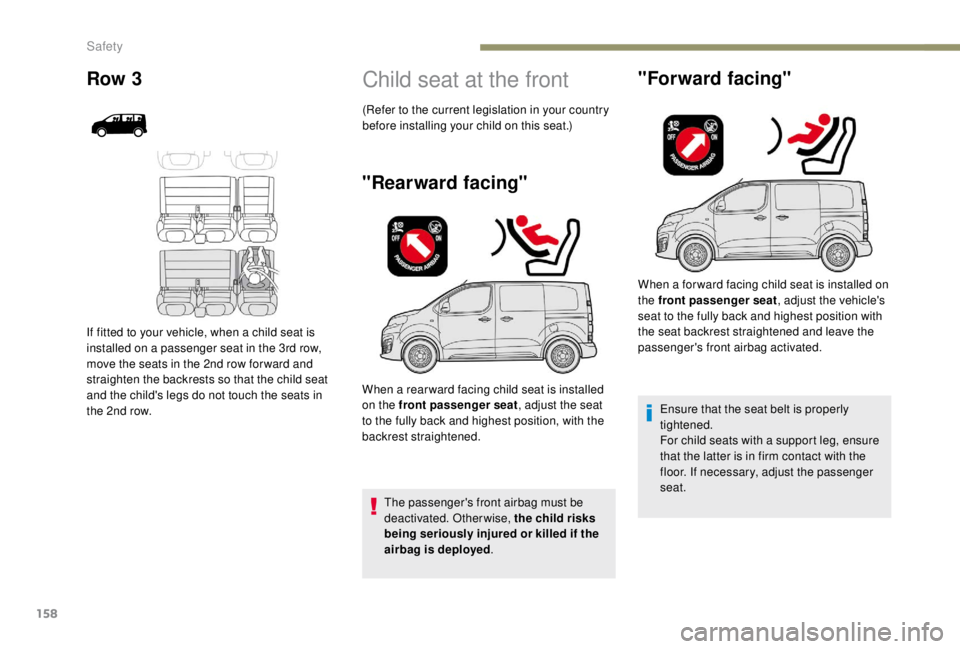
158
Child seat at the front
"Rearward facing"
The passenger's front airbag must be
deactivated. Otherwise, the child risks
being seriously injured or killed if the
airbag is deployed.
When a rear ward facing child seat is installed
on the front passenger seat
, adjust the seat
to the fully back and highest position, with the
backrest straightened.
"Forward facing"
When a for ward facing child seat is installed on
the front passenger seat , adjust the vehicle's
seat to the fully back and highest position with
the seat backrest straightened and leave the
passenger's front airbag activated.
Ensure that the seat belt is properly
tightened.
For child seats with a support leg, ensure
that the latter is in firm contact with the
floor. If necessary, adjust the passenger
seat.
(Refer to the current legislation in your country
before installing your child on this seat.)
Row 3
If fitted to your vehicle, when a child seat is
installed on a passenger seat in the 3rd row,
move the seats in the 2nd row for ward and
straighten the backrests so that the child seat
and the child's legs do not touch the seats in
the 2nd row.
Safety
Page 162 of 416
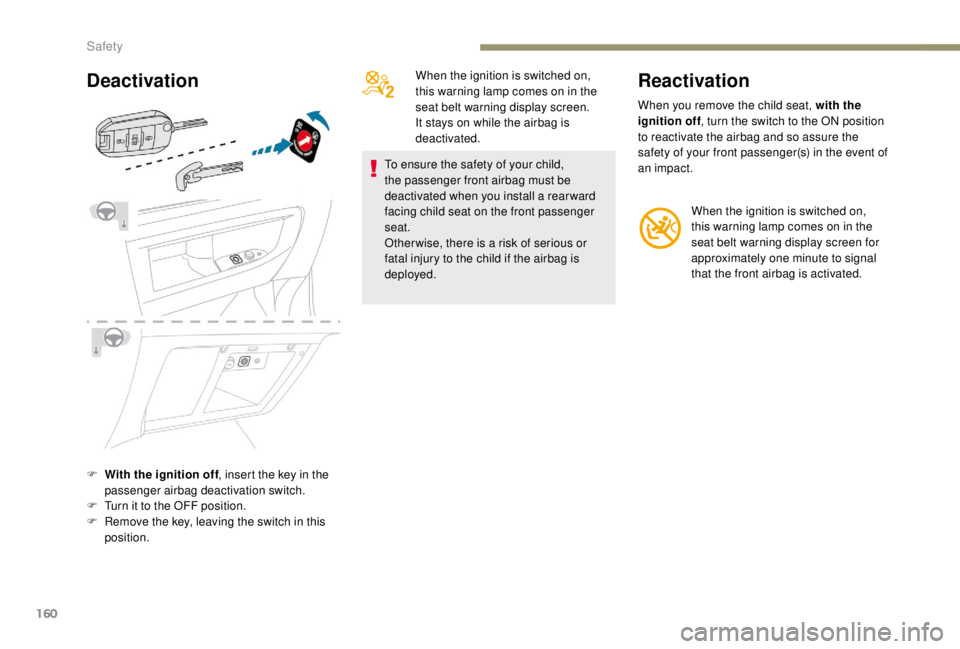
160
Deactivation
F With the ignition off, insert the key in the
passenger airbag deactivation switch.
F
T
urn it to the OFF position.
F
R
emove the key, leaving the switch in this
position. When the ignition is switched on,
this warning lamp comes on in the
seat belt warning display screen.
It stays on while the airbag is
deactivated.
To ensure the safety of your child,
the passenger front airbag must be
deactivated when you install a rear ward
facing child seat on the front passenger
seat.
Other wise, there is a risk of serious or
fatal injury to the child if the airbag is
deployed.
Reactivation
When you remove the child seat, with the
ignition off , turn the switch to the ON position
to reactivate the airbag and so assure the
safety of your front passenger(s) in the event of
an impact.
When the ignition is switched on,
this warning lamp comes on in the
seat belt warning display screen for
approximately one minute to signal
that the front airbag is activated.
Safety
Page 167 of 416
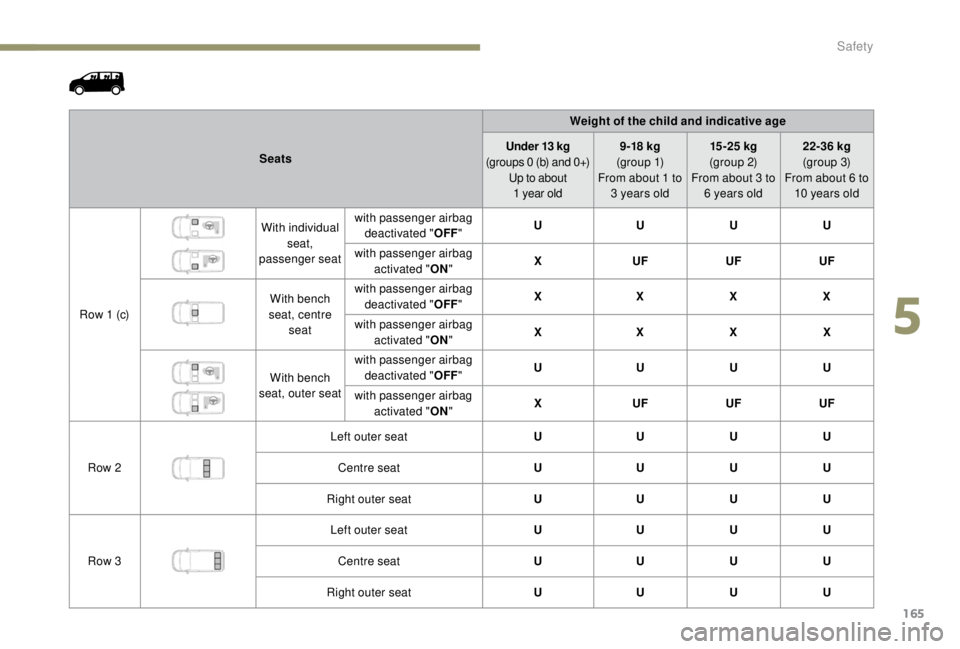
165
SeatsWeight of the child and indicative age
Under 13 kg
(groups 0 (b) and 0+)
Up to about
1
year old9 -18
kg
(g r o u p 1)
From about 1 to 3
years old15 -25
kg
(group 2)
From about 3 to 6
years old22-36
kg
(group 3)
From about 6 to 10
years old
Row 1
(c) With individual
seat,
passenger seat with passenger airbag
deactivated " OFF" U
UUU
with passenger airbag activated " ON" X
UFUFUF
With bench
seat, centre seat with passenger airbag
deactivated " OFF" X
XXX
with passenger airbag activated " ON" X
XXX
With bench
seat, outer seat with passenger airbag
deactivated " OFF" U
UUU
with passenger airbag activated " ON" X
UFUFUF
Row 2 Left outer seat
UUUU
Centre seat UUUU
Right outer seat UUUU
Row 3 Left outer seat
UUUU
Centre seat UUUU
Right outer seat UUUU
5
Safety
Page 168 of 416
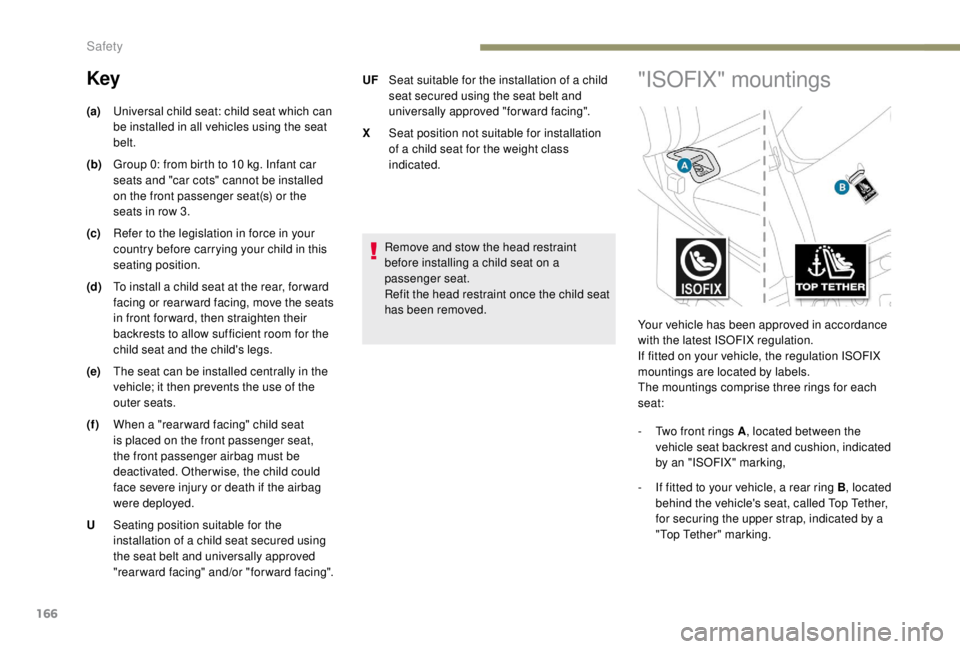
166
Remove and stow the head restraint
before installing a child seat on a
passenger seat.
Refit the head restraint once the child seat
has been removed.
(a)
Universal child seat: child seat which can
be installed in all vehicles using the seat
belt.
(b) Group 0: from birth to 10
kg. Infant car
seats and "car cots" cannot be installed
on the front passenger seat(s) or the
seats in row 3.
(c) Refer to the legislation in force in your
country before carrying your child in this
seating position.
(d) To install a child seat at the rear, for ward
facing or rear ward facing, move the seats
in front for ward, then straighten their
backrests to allow sufficient room for the
child seat and the child's legs.
(e) The seat can be installed centrally in the
vehicle; it then prevents the use of the
outer seats.
(f ) When a "rear ward facing" child seat
is placed on the front passenger seat,
the front passenger airbag must be
deactivated. Otherwise, the child could
face severe injury or death if the airbag
were deployed.
U Seating position suitable for the
installation of a child seat secured using
the seat belt and universally approved
"rearward facing" and/or "forward facing". UF
Seat suitable for the installation of a child
seat secured using the seat belt and
universally approved "forward facing".
X Seat position not suitable for installation
of a child seat for the weight class
indicated.
Key"ISOFIX" mountings
Your vehicle has been approved in accordance
with the latest ISOFIX regulation.
If fitted on your vehicle, the regulation ISOFIX
mountings are located by labels.
The mountings comprise three rings for each
seat:
-
T
wo front rings A , located between the
vehicle seat backrest and cushion, indicated
by an "ISOFIX" marking,
-
I
f fitted to your vehicle, a rear ring B , located
behind the vehicle's seat, called Top Tether,
for securing the upper strap, indicated by a
"Top Tether" marking.
Safety